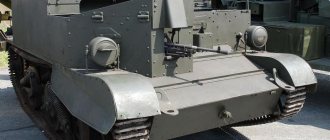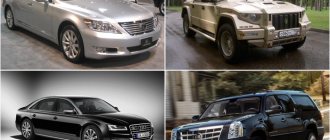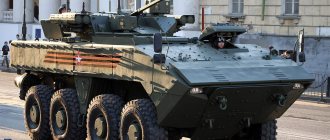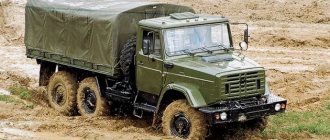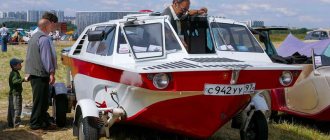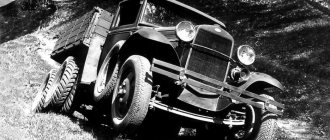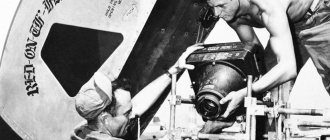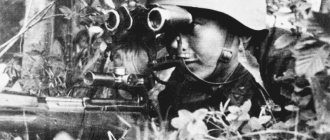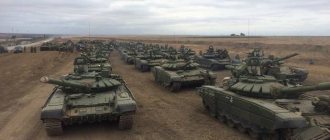“Niasilil, many letters”: ground equipment of the ground forces
For tanks, armored personnel carriers and other armored vehicles, designations are applied to the body - front and rear. In cars they are located on the bumper - again, on the front and rear. At first glance, this jumble of numbers and letters can be confusing, but if you look closely, everything turns out to be logical and easy to remember.
Here, for example, is the M1A1 Abrams tank from the Fort Stewart base in Georgia. Its frontal armor plate reads 3I 6-8CAV (left) and D14 (right). It is easy to understand what it is if you imagine that it is something like a postal address: first the city is written, then the street, house, apartment and, finally, the name of the addressee. It’s the same here—information goes from the general to the specific.
The division is listed first. In this case, the 3rd Infantry - hence 3I. Sometimes an infantry division may be designated ID rather than I. Tank divisions are designated A or AD (Armored Division).
Next come the battalion and regiment. 6-8CAV is the 6th Battalion, 8th Cavalry Regiment. Infantry battalions and regiments are designated INF (Infantry), tank battalions - ARM (Armored), reconnaissance - R or REC (Recon). There are also more exotic designations - say, EOD (explosive ordnance disposal), TMP (transport, Transportation Motor Pool), S&S (supply and service, Supply & Service). But they are usually found much less often in beautiful photographs.
D14 is the company, platoon and tank number. In this case, Company D or “Delta” (fourth - in the American army companies are not numbered, but are designated by letters), 1st platoon, tank number four. The Americans have four vehicles in a tank platoon; the commander's tank is always number 1, and his deputy's tank is number 4. Here we have exactly the latter case. It is worth noting that trailers for cars have the same number as the car itself, only the letter T is added to it (trailer, that is, “trailer”). That is, for example, an A23 truck will have an A2T3 trailer.
As you can see, everything is simple. However, only the army bothers with such long designations. The Air Force, Navy and Marine Corps are limited only by the registration number of the vehicle, which usually consists of five to eight digits and cannot be deciphered - it is just a serial number.
Likely enemy: United States military vehicles
We have been running a military column for quite some time now and have managed to study old and new Russian equipment, foreign cars in service in the Russian Federation, Ukrainian military vehicles, as well as European army trucks. Now we turn our gaze overseas and again want to emphasize that our publications do not carry any political overtones.
Also, before we talk about a number of outstanding American military vehicles, it is worth noting that the US military industry is incredibly well developed and the market is filled with competition from private companies that offer dozens of different vehicles.
We will look at only a small part of them, and this list will include both advanced and very archaic designs.
1 / 3
2 / 3
3 / 3
HMMWV photo: amgeneral.com
HMMWV
Length: 4.6 meters. Engine: 6.5 liter V8 turbodiesel. Recoil: 190 hp and 380 Nm. Transmission: 3-speed automatic transmission, 4x4 drive. Curb weight: 2,676 kg. Maximum speed: 88 km/h. Ground clearance: 410 mm.
When we say “American military vehicle,” the first thing we think of is it, dear. And even though the “old Humvee” is already being written off quite en masse, it has been in service for almost 30 years and deserves a separate paragraph in this material. First, a little about the name. HMMWV is nothing more than a High Mobility Multipurpose Wheeled Vehicle, that is, a “highly mobile multipurpose wheeled vehicle.” Americans love nicknames, so soon the “sophisticated” abbreviation turned into a consonant Humvee. 13
2 / 3
3 / 3
HMMWV photo: amgeneral.com
Many people mistakenly think that the Humvee is the brainchild of General Motors, but this is not the case. In fact, the model was invented in the late 70s and is still produced to this day by AM General, which has nothing to do with GM, despite similar names. This defense firm was once part of the Kaiser-Jeep corporation, so you could say that the Humvee is in some way the heir to the legendary Willys from World War II. In the early 90s, the GM concern simply bought the rights to produce a civilian version of the HMMWV under the consonant and more brutal name Hummer (“hammer”), especially since General Motors was initially the supplier of engines for the model’s cars. After the “freezing” of this project, the production of the military modification continued.
HMMWV photo: amgeneral.com
Flyer ALSV – Advanced Light Strike Vehicle
Length: 4.57 meters. Engine: 1.9 liter turbodiesel. Recoil: 150 hp and 350 Nm. Transmission: 6-speed automatic transmission, 4x4 drive. Curb weight: 2,041 kg. Maximum speed: 136 km/h. Ground clearance: 350 mm.
Military vehicles don't have to be big and scary. Guided by this consideration, the Americans in the late 70s became concerned with creating light and fast transport for patrolling the desert. The contractor for the order was a small company, Chenowth Racing Products from California. That vehicle was called a DPV, which literally stands for “desert patrol vehicle,” and was more like a buggy. He could move quickly across the sand and carry machine guns. Such gizmos were useful to the American military during Operation Desert Storm in the Persian Gulf. In the 90s, they were replaced by the structurally similar LSV - “light attack vehicle”. Now “advanced” ones are being purchased for the army, that is, Advanced LSVs, which have received their own name - Flyer (“flyer”). They are produced by the Californian, again, defense concern Marvin Group. These cars are much less like buggies, although their strong point remains speed on rough terrain. If you believe the passport specifications, the approach and departure angles are 59 and 50 degrees, respectively. There are options for carrying cargo and transporting the wounded, as well as versions equipped with machine guns and even armor for participation directly in combat operations. The vehicles are relatively compact and can be transported by helicopter both externally and internally.
Flyer ALSV – Advanced Light Strike Vehicle photo: gd-ots.com
International MaxxPro
Length: 6.5–7.2 meters. Engine: 9.3 liter Navistar DT turbodiesel. Recoil: 330–375 hp Transmission: 5-speed automatic transmission, 4x4 drive. Curb weight: 12,700 – 14,500 kg. Ground clearance: 350 mm.
This monster, like other trucks under the International brand, is produced by Navistar Corporation. It's been called the successor to the Humvee, but that's not entirely true. Part of the functions of the Humvee are performed by the above-mentioned Flyer, and the MaxxPro is not just a car, but a heavy MRAP - Mine Protected Ambush Resisted, that is, a vehicle protected from mines and ambushes. 13
2 / 3
3 / 3
International MaxxPro photo:
wikipedia.org
The V-shaped bottom, which dissipates the shock wave, helps it perform these functions. The Russian Typhoon-M and Typhoon-K have a similar design, which we already wrote about in our review of promising Russian weapons. There is a lot of controversy surrounding the combat effectiveness of MaxxPro. In particular, military experts (including American ones) say that four wheels are not enough for an armored car, because after a mine explosion it, left without one or two wheels, will not be able to move further. Nevertheless, more than 9,000 copies of several modifications have already been built in the USA and many of them have been exported to the armies of European countries. It is worth noting that, in addition to the MaxxPro mentioned in this article, the American army has several other MRAP modifications at its disposal, including the three-axle Buffalo and Caiman.
International MaxxPro photo: wikipedia.org
Oshkosh M1070 Heavy Equipment Transporter
Length: 15.8 meters. Engine: Detroit Diesel Series 92 8V92. Recoil: 500 hp Transmission: 5-speed automatic transmission, 8×8 drive. Curb weight: 19,500 kg. The Americans didn’t think about the name for a long time, so the car is called the “Heavy Equipment Transporter.” Indeed, the mighty structure is capable of carrying up to 64 tons, albeit very slowly - the maximum speed is 72 km/h.
Oshkosh M1070 Heavy Equipment Transporter photo:
oshkoshdefense.com
The current version of the heavy truck has been in production since 1993, and it is assembled by one of the oldest manufacturers of special and military equipment - the Oshkosh Corporation from Wisconsin. The M1070 is mainly used for transporting tanks and other tracked vehicles. In addition to the US Army, they are the main heavy transport of the British - for the sake of supplies to the Old World, the Americans managed to adapt their ancient V-shaped Detroit diesel engine to Euro-3 standards.
Oshkosh M1070 Heavy Equipment Transporter photo: oshkoshdefense.com
Dragon Runner
Length: 38 cm. Curb weight: 4 kg. To reduce human losses in battle, the Americans are actively introducing unmanned vehicles. "Dragon Runner" is one of a dozen serial mobile robots, and we chose it mainly because it is closer in appearance to cars than others. The rest, as a rule, are on tracks or with “legs”. It is assumed that this baby can be carried away by a soldier in a backpack and, if necessary, thrown out for reconnaissance. Throw it away - in the literal sense of the word, because the Dragon Runner can withstand a fall onto hard ground from a vehicle moving at speeds of up to 70 km/h. Its wheels are larger than the body, so it doesn’t matter which side you fall on. Dragon Runner’s “weapons” include only a camera, a microphone and a motion sensor, plus a transmitter for sending information to the “base”. The robots are assembled in Pennsylvania, at the Automatika production facility. Since 2010, they have been working in Afghanistan to explore dangerous areas and search for mines.
Dragon Runner photo: wikipedia.org
Send in two letters: Air Force logic
The most noticeable detail of American Air Force aircraft is the two letters on the tail. What do they mean? Base location. For example, in the photo below are F-15E fighters from the 335th Fighter Squadron. By the way, the car on the left under two letters has the corresponding mark - 335FS (Fighter Squadron). The 335th is located at Seymour-Johnson Air Force Base in North Carolina - hence the letters SJ (Seymour Johnson). Below you can see the aircraft number and the letters AF - Air Force, that is, the Air Force.
Other air bases are being reduced in a similar manner. For example, ED (Edwards Base in California), HL (Hill Base in Utah), LN (Lakenheath in the UK).
However, if everything were so simple and logical, it would not be aviation (which, as you know, begins where order ends). Let's say, the F-22s living at Elmendorf-Richardson Air Force Base do not bear the letters EL, not ED, not ER or any other similar letters, but AK. Because the base is located in Alaska. And aircraft from Kadena Air Base in Japan are generally designated ZZ. Why? Shrouded in mystery. There may be some interesting story behind this, but we will most likely never know.
Sometimes it happens that the abbreviations themselves are thrown out along with the logic. The South Carolina National Guard aircraft, for example, have South Carolina written on their fins. Proudly and without cuts. True, these are still the national guard, “weekend warriors”, they are not like people...
Did you think the army had a lot of letters? Look at the fleet!
The US Navy often operates on the principle of “any way you like, as long as it’s not like the land rats.” Therefore, although the aircraft of the Navy and Marine Corps wear two letters on the tail, they have a completely different meaning. The first letter symbolizes the fleet. Atlantic - A, Pacific - suddenly - N (and not P for Pacific, as one might think). The second is the air wing code, which is unique for everyone. Below in the photo is an F/A-18E fighter-bomber of the 8th Wing. It is based on the aircraft carrier USS George W. Bush in the Atlantic and is designated by the letter J, hence the designation AJ on the fins of the aircraft.
In addition to the letters on the fin, seaplanes and helicopters carry long abbreviations. The first letter indicates the type of aircraft the squadron is armed with: V (airplanes) or H (helicopters). Further, if the squadron belongs to the Marine Corps, the letter M is placed. The last two letters indicate the occupation of the squadron. Here is the list:
A - strike/assault C - combat F - fighter P - patrol Q - electronic warfare S - anti-submarine W - radio detection and guidance
The abbreviation is followed by the squadron number. That is, the same F/A-18E in the photo above, designated VFA-31 on the fuselage, belongs to the 31st Fighter Attack Squadron. And the same one in the photo below is for the 115th Fighter-Assault Squadron of the US Marine Corps.
M1A1SA Abrams
E units - 775 units
This version of the Abrams is older, but the vehicles or tanks in US service are still in service. They belong to the first generation of American cars. Weight is about 61 tons and it is a heavyweight. It is equipped as standard with a 105 mm M68A3 cannon. The ammunition load contains 55 units. US tanks 2021 Abrams “1” use 1.5 thousand horsepower air-cooled gas turbine engines. In theory, the M1A1SA Abrams was intended for use in other countries, such as Morocco, but the armed forces decided to keep a huge number of units for themselves. Therefore, tanks remain in US service and work for the benefit of the army.
- Weight: 61.3 t.
- Length: 9,828 mm
- Height: 2,400 mm
- Width: 3,653 mm
- Gun caliber: 105 mm
- Engine power: 1,500 l. With.
- Speed: 66.8 km/h
What is the saxophonist's number?
And finally, as a bonus, the digital codes of military specialties of the US Marine Corps. These are not technical designations, but they may also be interesting. The full list can be found here (in English), but we will present the most interesting options:
0311 - shooter 0313 - light armored vehicle crew member 0317 - reconnaissance sniper 0911 - drill instructor 1812 - tank crew member 2783 - translator from Hungarian 2791 - translator from Russian 4641 - photojournalist 5537 - saxophonist 8411 - recruiter
These numbers have become part of Marine jargon, so don't be surprised to hear something like, "Hey, two seven eight three, what's the Hungarian word for 'surrender'?"
M1A2 SEP v2 Abrams
Units – 1,611
These are tanks mounted on the popular military combat platform Abrams, in the second generation. The first vehicles of this modification appeared back in 1992, they received a thermal imaging sight, gunner updates and much more. These particular US tanks M1A2 SEP v2 Abrams appeared in 2008. By controlling them, operators can monitor the situation through displays that have become color. The engine was also improved and innovative technologies were introduced.
The main armament of the US 2022 tanks is a 120 mm M256 cannon. It is produced by the Germans, but only using a license from the Americans. Speaking of ammunition, the latest innovative technologies have already been used. The armor-piercing projectile is made using a uranium alloy, so it will not be a problem for it to penetrate steel with a thickness of more than 75 centimeters, despite the fact that the distance to it from the tank will be 2 kilometers. The maximum distance of such shells is 3.5 kilometers.
Another advantage why tanks in the US arsenal are considered one of the best is the mass of the M1A2 SEP v2 Abrams, reaching 62.5 tons; the standard ammunition load is 40 units. The auxiliary weapons include 3 machine guns, two 7.62 mm and one 12.7 mm. The tank's engine has a power of 1,500 horsepower, which allows the 62-ton vehicle to move along the highway at a speed of 67 kilometers per hour. A full tank lasts for 470 kilometers.
- Weight: 62.5 t.
- Length: 9,830 mm
- Height: 2,430 mm
- Width: 3,660 mm
- Gun caliber: 120 mm
- Engine power: 1,500 l. With.
- Speed: 67 km/h

